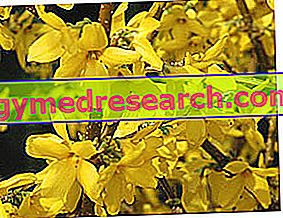Introduction
The canary yellow of its flowers is incomparable: forsythia is a rather "intrusive" shrubbery, in some ways, but even before the dawn of spring its colored corollas paint and embellish the still sparse vegetation.

The strange name of the plant originates from Mr. W. Forsyth, founder of the Royal Society of Horticulture in London, one of the most renowned 18th century botanical associations worldwide.
Botanical description
For its luxuriance, forsythia is considered one of the most generous shrubby plants ever: not surprisingly, the plant gives the nature many, splendid, yellow flowers, in addition to releasing an intense fragrance in the environment.
In botany, forsythia is an exponent of the Oleaceae family : the genus Forsythia includes seven shrub species, including F. vividissima, probably the progenitor. Do not forget also F. ovata and F. suspensa.
The forsizie are native plants of the south-eastern European lands, of China and Japan, where they are cultivated above all as ornament.
Rustic forsythia plants do not generally exceed 3 meters in height: the leaves, roundish or oblong, are deciduous, and are distributed on slender, linear branches, colored with ocher or brownish. As mentioned, the forsythia is distinguished by the period corresponding to the flowering: even before the arrival of spring, the plant gives to the naked vegetation beautiful yellow flowers with four lobes, which bloom in small groups from three to the axils of the leaves, forming much foliage thick and thick.
According to the thought of some authors, forsythia is a freak of nature, given that the bright yellow color of its flowers appears so loaded as to be considered even excessively aggressive, in a still dormant vegetative context.
Features
The cultivation of forsythia is very simple: in general, the plant requires abundant watering during the summer and an important pruning immediately after the fall of the flowers, leaving few gems in order to develop new branches that will flower the following year.
It is advisable to eliminate some central branches, in order to thin out the foliage and avoid an excessive weakening of the branches in formation.
The forsythia does not require particular types of soil, nor is it a plant demanding in terms of climate: the shrub, in fact, grows well even in universal soils, provided they are fresh. The plant is also resistant to frost and drought; however, forsythia loves direct sunlight.
The multiplication takes place by semi-woody cutting.
Although it lends itself perfectly as a bush in free form, the forsfizia can be given a particular pyramidal or sapling shape, depending on the needs. [taken from the writings of Dr. V. Pironi, www.orticolario.it/]
Property of forsythia
In Oriental medicine, forsythia is used as an anti-inflammatory and antiallergic: these virtues are probably ascribed to the forsiteoside and to the verbascoside, glycosylated phenyl propane which is responsible for the formation of hydroperoxide molecules.
Many texts do not attribute any phytotherapeutic property to forsythia, attributing it to the simple label of a decorative element; only recently, some active ingredients (phyllirin, rutin, cyclohexanol rengiolus) have been isolated, to which anti-emetic virtues (forsythia fruits) are ascribed.
Summary
Forsythia: to fix the concepts
| forsythia | A rather "intrusive" shrub, cultivated above all for ornamental purposes, due to its golden and iridescent floral foliage One of the most generous shrubby plants ever |
| Forsythia: origin of the name | The strange name of the plant originates from Mr. W. Forsyth, founder of the Royal Horticulture Society in London |
| Forsythia: botanical description |
|
| Forsythia: general characteristics | Pint cultivation: simple Climatic requirements: scarce Water requirements: requires abundant watering in summer Pruning: important pruning after the fall of the flowers + crown thinning Soil: universal, fresh Climate: resistant to frost and drought Light: love direct lighting Multiplication: by semi-woody cutting |
| Forsythia: property |
|
| Forsythia: active ingredients |
|



